
Journal of Advanced Dielectrics
Scope & Guideline
Bridging Theory and Application in Material Science
Introduction
Aims and Scopes
- Dielectric Properties of Materials:
Research on the dielectric properties of various materials, including ceramics, polymers, and composites, with a focus on understanding their behavior under different conditions. - Ferroelectric and Piezoelectric Materials:
Studies aimed at the synthesis, characterization, and application of ferroelectric and piezoelectric materials, including lead-free options, to enhance performance in electronics and sensors. - Advanced Characterization Techniques:
Utilization of advanced characterization methods such as impedance spectroscopy, electron microscopy, and X-ray diffraction to investigate the microstructural and electrical properties of dielectrics. - Energy Storage and Conversion:
Research focused on optimizing energy storage capabilities of dielectric materials, particularly in applications for capacitors and energy harvesting devices. - Multifunctional Dielectrics:
Exploration of multifunctional dielectric materials that exhibit properties such as magnetoelectricity, electrocaloric effects, and photocatalytic activity. - Theoretical and Computational Modeling:
Development of theoretical models and computational simulations to predict and explain the behavior of dielectric materials at atomic and macroscopic levels.
Trending and Emerging
- Lead-Free Dielectrics:
There is a strong trend towards research on lead-free dielectric materials, driven by environmental regulations and the need for sustainable alternatives in electronics. - Energy Storage Optimization:
A growing focus on optimizing energy storage capabilities of dielectric materials, particularly for applications in capacitors and energy conversion devices, is evident in recent publications. - Nanocomposite Materials:
The exploration of nanocomposites that leverage the unique properties of nanoscale materials to enhance dielectric performance is increasingly popular, highlighting innovative approaches to material design. - Integration of Machine Learning:
The use of machine learning techniques to predict and optimize dielectric properties and behaviors is emerging as a significant trend, reflecting the intersection of materials science and computational modeling. - Advanced Characterization Techniques:
There is a marked increase in the application of advanced characterization methods, such as atomic-scale imaging and spectroscopy, to gain deeper insights into the microstructure and properties of dielectrics. - Multifunctional Materials:
Research is increasingly focusing on multifunctional dielectric materials that exhibit combined properties, such as piezoelectricity and photocatalysis, which can lead to novel applications in various fields.
Declining or Waning
- Traditional Ferroelectric Materials:
Research specifically focused on conventional lead-based ferroelectric materials has decreased, possibly due to increasing regulatory and environmental concerns, leading to a shift towards lead-free alternatives. - Low-Temperature Processing Techniques:
The interest in low-temperature processing methods for dielectric materials appears to be waning, as researchers increasingly pursue advanced techniques that allow for better material performance and scalability. - Magnetic-Di-electric Coupling:
The study of magnetoelectric effects in dielectric materials has seen reduced attention, possibly overshadowed by more pressing research in energy storage and conversion technologies. - Optical Properties of Dielectrics:
Research focusing exclusively on the optical properties of dielectric materials is less common, as studies are now more integrated with electrical and structural properties. - Applications in Traditional Electronics:
As the field evolves, there is a noticeable decline in studies aimed at traditional applications in electronics, with a pivot towards more innovative and multifunctional uses.
Similar Journals
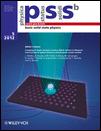
PHYSICA STATUS SOLIDI B-BASIC SOLID STATE PHYSICS
Connecting Researchers Through Groundbreaking Physics InsightsPHYSICA STATUS SOLIDI B-BASIC SOLID STATE PHYSICS, published by Wiley-VCH Verlag GmbH in Germany, is an esteemed journal within the condensed matter physics sphere, covering pivotal advancements in basic solid state physics. With a rich history dating back to 1961, it serves as a scholarly platform for researchers, professionals, and students alike, providing insights into the fundamental properties and applications of electronic, optical, and magnetic materials. The journal currently holds a respectable Q3 ranking in both Condensed Matter Physics and Electronic, Optical, and Magnetic Materials as of 2023, indicating its impactful contributions to these fields despite its competitive landscape. While it does not offer open access, its comprehensive research findings are critical for those engaged in innovative material science research. With a convergence period extending to 2024, PHYSICA STATUS SOLIDI B continues to play a significant role in facilitating knowledge exchange and fostering advancements in solid state physics.
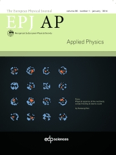
EUROPEAN PHYSICAL JOURNAL-APPLIED PHYSICS
Exploring New Dimensions in Physical SciencesEUROPEAN PHYSICAL JOURNAL-APPLIED PHYSICS, published by EDP SCIENCES S A in France, serves as a vital platform for the dissemination of cutting-edge research in the fields of condensed matter physics, electronic, optical and magnetic materials, and instrumentation. With an ISSN of 1286-0042 and E-ISSN of 1286-0050, this journal has been a valuable resource for researchers since its inception in 1998, aiming to foster innovation and dialogue among professionals and academics alike. Featuring an impact factor that reflects its growing influence, the journal is currently ranked in the Q4 quartile for several related categories in 2023, underscoring its ongoing contributions to the scientific community despite its relatively competitive positioning. Access to the journal is available through various Open Access options, ensuring that pioneering research is readily accessible to all. As it continues to evolve towards its 2024 objectives, EUROPEAN PHYSICAL JOURNAL-APPLIED PHYSICS remains dedicated to advancing knowledge and facilitating collaboration in applied physics, making it an essential resource for students, researchers, and professionals dedicated to exploring the forefront of physical sciences.

JOURNAL OF ELECTROCERAMICS
Unveiling Cutting-edge Discoveries in Materials ScienceJOURNAL OF ELECTROCERAMICS, published by SPRINGER in the Netherlands, serves as a pivotal platform for advancing the field of electroceramics since its inception in 1997. With a keen focus on innovative materials and applications, this journal covers diverse areas encompassing ceramics and composites, condensed matter physics, and electronic materials, significantly contributing to interdisciplinary research. Although currently not an Open Access publication, the journal's engagement in rigorous peer review ensures the dissemination of high-quality research, supported by its respectable Q3 ranking in several relevant categories in 2023. Researchers and professionals will find value in its comprehensive scope, showcasing cutting-edge developments that shape the future of engineering and materials science. The JOURNAL OF ELECTROCERAMICS continues to play a crucial role in bridging theoretical discoveries with practical applications, making it an indispensable resource for students, scholars, and industry experts alike.
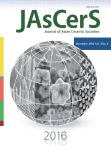
Journal of Asian Ceramic Societies
Bridging cultures through ceramic research.The Journal of Asian Ceramic Societies, published by Taylor & Francis Ltd, is a peer-reviewed open-access journal that has been at the forefront of ceramic research since its inception in 2013. With an ISSN of 2187-0764, this esteemed journal is dedicated to advancing the scientific understanding of ceramics and composites, bolstered by an impressive ranking of Q2 in the field of Materials Science. Covering a wide range of topics pertinent to ceramics, the journal aims to foster collaboration among researchers, professionals, and students across Asia and beyond. Its commitment to accessibility allows a global audience to engage with cutting-edge research, reflected in its Scopus ranking of #45 out of 127 in the Materials Science category. With a publication timeline extending to 2024, the Journal of Asian Ceramic Societies is an indispensable resource for anyone looking to stay informed on the latest developments and innovations in ceramic technology.
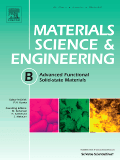
Materials Science and Engineering B-Advanced Functional Solid-State Materials
Leading the Charge in Advanced Solid-State ResearchMaterials Science and Engineering B: Advanced Functional Solid-State Materials, published by Elsevier, stands as a pivotal platform in the realm of materials science, focusing on the development and characterization of advanced solid-state materials. With an ISSN of 0921-5107 and E-ISSN of 1873-4944, this journal operates out of the United Kingdom and addresses critical issues in condensed matter physics, mechanical engineering, and mechanics of materials. Its consistent recognition, evident in its Q2 quartile rankings across multiple engineering and physics categories and a respectable scope of convergence from 1988 to 2024, signifies its substantial contribution to the field. Researchers and professionals seeking a venue for cutting-edge work will appreciate the journal's commitment to advancing knowledge in functional materials, with its open access features ensuring that innovative findings are readily accessible. Join a community of leading scholars engaging with the latest advancements, shaping the future of materials science.
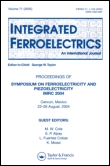
INTEGRATED FERROELECTRICS
Bridging Disciplines for a Sustainable FutureINTEGRATED FERROELECTRICS is a prominent academic journal published by Taylor & Francis Ltd, focusing on the interdisciplinary study of ferroelectric materials and their applications. Since its inception in 1992, it has provided a platform for high-quality research and innovative findings within fields such as ceramics and composites, condensed matter physics, and electrical engineering. Despite currently holding a Q4 quartile ranking across several categories—including Ceramics and Composites and Electrical and Electronic Engineering—the journal plays a crucial role in disseminating knowledge and fostering collaboration among scientists and engineers dedicated to advancing ferroelectric technology. With an increasing emphasis on the practical applications of electronic and optical materials, INTEGRATED FERROELECTRICS offers valuable insights for researchers, providing them with a repository of knowledge that is essential for both academic exploration and practical implementation.

Applied Science and Convergence Technology
Unleashing Potential at the Intersection of Science and EngineeringApplied Science and Convergence Technology (ISSN: 2288-6559) is a premier academic journal published by the Korean Vacuum Society, dedicated to advancing knowledge in the intersecting fields of condensed matter physics, electrical and electronic engineering, materials science, and theoretical chemistry. Based in South Korea, this journal serves as an essential platform for researchers, professionals, and students seeking to explore innovative applications and methodologies that drive convergence in science and technology. With a convergence period spanning from 2019 to 2024, the journal aims to publish high-quality original research and review articles that foster collaboration and knowledge sharing across disciplines. Its current quartiles position in top categories, alongside a respectable rank in Scopus, highlights its significance within the scientific community, although it is presently classified within lower tiers. The journal's commitment to open access ensures that vital research findings are accessible to a global audience, facilitating advancements in science and technology. As a notable outlet in its field, Applied Science and Convergence Technology continues to attract contributions that not only challenge current paradigms but also pave the way for future innovations.

JOURNAL OF MATERIALS SCIENCE-MATERIALS IN ELECTRONICS
Driving Progress in Electronic Materials ResearchJOURNAL OF MATERIALS SCIENCE-MATERIALS IN ELECTRONICS, published by Springer, is a distinguished international journal that serves as a vital platform for the dissemination of cutting-edge research in the field of materials science, with a keen focus on electronics. Since its inception in 1990, this journal has consistently contributed to the advancement of knowledge across a range of interdisciplinary categories, including Atomic and Molecular Physics, Optical and Magnetic Materials, and Biomedical Engineering, achieving notable quartile positions in various 2023 Scopus rankings. With an impact factor that signifies its scholarly influence, this journal provides a rigorous peer-reviewed environment for researchers and practitioners to share innovative ideas, experimental findings, and theoretical developments. Although it does not currently offer open access options, the depth and breadth of topics covered—including condensed matter physics and bioengineering—make it an essential resource for those at the forefront of materials research. With a commitment to bridging the gap between theory and practical application, the JOURNAL OF MATERIALS SCIENCE-MATERIALS IN ELECTRONICS continues to pave the way for future explorations in the ever-evolving landscape of materials science.

AIP Advances
Unlocking New Horizons in Nanoscience and Physics.AIP Advances, published by AIP Publishing in the United States, is an esteemed open-access journal that has been pivotal in disseminating knowledge in the fields of Nanoscience and Nanotechnology and Physics and Astronomy since its inception in 2011. With an unwavering commitment to enhancing global scientific communication, the journal provides a platform for groundbreaking research and innovative methodologies, catering to a diverse audience of researchers, practitioners, and students. As of 2023, AIP Advances enjoys a respectable impact factor that reflects its significance in the academic community, ranking in the Q3 category for both Nanoscience and Nanotechnology and Physics and Astronomy. The journal has made its contributions accessible, reinforcing its mission of promoting collaboration and knowledge sharing across disciplines. Researchers interested in publishing their work will find AIP Advances not only a valuable medium for their findings but also a hub for the latest advancements and discussions shaping these dynamic fields.
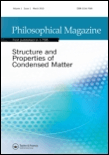
PHILOSOPHICAL MAGAZINE
Bridging Ideas and Discoveries in PhysicsPHILOSOPHICAL MAGAZINE, published by Taylor & Francis Ltd, is a distinguished journal that focuses on the field of Condensed Matter Physics. With an ISSN of 1478-6435 and an E-ISSN of 1478-6443, this journal serves as a vital platform for researchers and professionals seeking to disseminate and access cutting-edge research and developments in the field. Currently ranked in the Q3 category within its discipline according to the 2023 quartiles, and positioned at the 45th percentile in Scopus rankings, PHILOSOPHICAL MAGAZINE is recognized for its significant contributions to theoretical and experimental physics. The journal embraces open access options, enhancing its reach and accessibility to a global audience. With coverage spanning from 2003 through 2024, it remains a cornerstone for scholars and students who aim to deepen their understanding of the complexities within condensed matter systems. For anyone engaged in the physical sciences, PHILOSOPHICAL MAGAZINE offers invaluable insights and fosters an environment of rigorous academic inquiry.